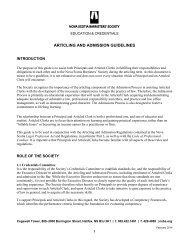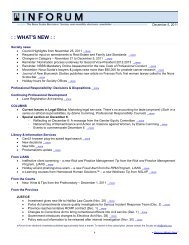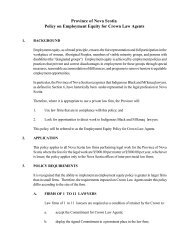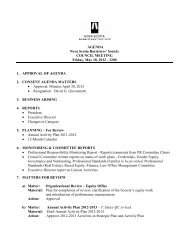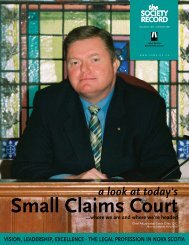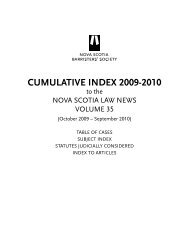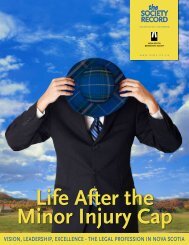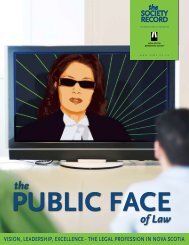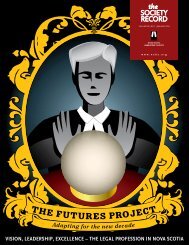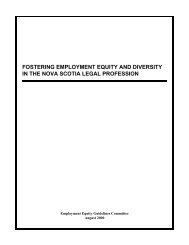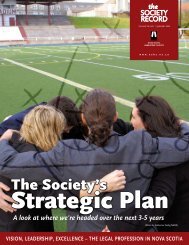SR Vol 27 No 4, October 2009 - Nova Scotia Barristers' Society
SR Vol 27 No 4, October 2009 - Nova Scotia Barristers' Society
SR Vol 27 No 4, October 2009 - Nova Scotia Barristers' Society
- No tags were found...
Create successful ePaper yourself
Turn your PDF publications into a flip-book with our unique Google optimized e-Paper software.
Equity and diversity inthe legal profession:The legacy of Donald Marshall JuniorEmma HalpernNSBS Equity OfficerOn August 6, <strong>2009</strong>,Donald Marshall Junior,son of the late GrandChief of the Mi’kmaq Nation,passed away in Sydney, <strong>No</strong>va<strong>Scotia</strong>. His death has inspiredmany Canadians to reflect on hislegacy, especially the profoundand lasting impact his experienceand his actions have had on thejustice system and the lives ofa great number of individualsin <strong>No</strong>va <strong>Scotia</strong>, Canada andbeyond.In the weeks following his passing,Mr. Marshall has been referred toas an icon, influential figure andactivist. Although these terms are certainly accurate, they do not dojustice to the depth of sacrifice he made nor to his effect on the justicesystem and the struggle to entrench the rights of Aboriginal peoplein <strong>No</strong>va <strong>Scotia</strong>.In a tragic twist of fate, Marshall sacrificed 11 years of his life so thatthe discriminatory attitudes present at all levels of the justice systemcould be brought to light and addressed. He spent much of his youthin prison after being wrongfully convicted of murder in the 1971stabbing death of Sandy Seale in Sydney. He was released in 1982,acquitted in 1983 and finally exonerated in 1989, following the releaseof the report of the Royal Commission on the Donald Marshall, Jr.,Prosecution into the wrongful murder conviction (hereinafter theMarshall Commission Report). The inquiry concluded that Marshallwas a victim of racism and incompetence and that he was failed bythe <strong>No</strong>va <strong>Scotia</strong> legal system at every turn. 1<strong>No</strong>w, 20 years since the Commission released this landmark report,what—if anything—has changed?1 It is also important to note that a number of years later, while outeel fishing at Pomquet Harbour near Cape Breton Island, he found himselfaccidentally embroiled in a court case that would again require him to make asignificant personal sacrifice so that the Mi’kmaq and Maliseet people in AtlanticCanada would have the right to earn a moderate livelihood from hunting,fishing and gathering. After a lengthy court battle, in 1999 the Supreme Courtof Canada upheld a centuries-old treaty between the Mi’kmaq people and theBritish Crown in acquitting Marshall of illegal fishing.It is important to mention at the outset that given the length (82recommendations, seven volumes, over 1,000 pages) and depth ofthe Marshall Commission Report and the numerous and extensivechanges to the justice system that were brought about as a result of thisdocument, it is virtually impossible to even come close to addressingevery issue in a short article. I have, therefore, selected a few keypoints that pertain directly to my role as Equity Officer and the lensthrough which I view the legal profession, omitting consideration ofmany other aspects that are no less significant for <strong>No</strong>va <strong>Scotia</strong>.At the <strong>No</strong>va <strong>Scotia</strong> Barristers’ <strong>Society</strong>, the creation of both theEquity Office and the Race Relations Committee, as a direct resultof the Marshall Commission Report, has helped the profession betterunderstand the impact of racism and discrimination and has beena strong force in encouraging the implementation of policies andprogramming dedicated to furthering equality within the profession.Other noteworthy changes in the area of equity within the legalprofession that have been supported by recommendations from theMarshall Commission Report are the creation of the IndigenousBlacks & Mi’kmaq Initiative at Dalhousie Law School 2 , the Mi’kmaqLegal Support Network 3 , and the introduction of diversity as acriterion in hiring policies at all levels of the justice system, frompolicing to the judiciary.These programs and policies are important first steps in demonstratinga commitment to equity and diversity in regard to legal educationand legal support programs, and in acknowledging the importance ofdiversity within the legal profession. Unfortunately, however, despitethese clear steps forward, we still have a long way to go before we cancomfortably say that the racism and discrimination highlighted in theMarshall Commission Report have been sufficiently addressed.It is still the case that the experience of many African <strong>No</strong>va <strong>Scotia</strong>nand Mi’kmaq people has illustrated to them that the justice systemis unaware of cultural differences, and remains dominated by whiteEuropean-descended people whose values and norms, notwithstandingthe policies and programming encouraging diversity, unwittingly giverise to discriminatory practices and decision making.2 The IB&M Initiative was created to reduce structural and systemicdiscrimination by increasing the representation of Indigenous Black andMi’kmaq people in the justice system.3 MLSN exists to ensure fair, culturally appropriate treatment ofMi’kmaq and Aboriginal people within the justice system.28 The <strong>Society</strong> Record



